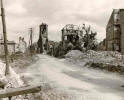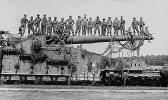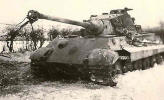|
CLOSING DAYS OF THE WAR IN
GERMANY |
 Ludendorff
Bridge at Remagen, built in WW-I, was the last standing on the Rhine
and was captured on 7 March 1945. only a limited number of troops were
able to cross the Rhine before the bridge's collapse. Ludendorff
Bridge at Remagen, built in WW-I, was the last standing on the Rhine
and was captured on 7 March 1945. only a limited number of troops were
able to cross the Rhine before the bridge's collapse.
(courtesy Rex Combs collection) |

Hurtgen, Germany
east of the Belgian-German border was the scene of one of the most
fierce battles in WW-II
(courtesy Rex Combs collection) |
 German
Artillery German
Artillery
In April 1945, troops of the Seventh US Army captured this
274mm railroad gun near Rentwetshausen in central Germany. The
mammoth easily holds these 22 men lined up on the barrel. Although of an
1887 French design, the gun packs a powerful wallop.
Could this be the same gun that bombarded the 81mm Mortar Platoon
of the 2nd Battalion of the 508th during Operation Market Garden in 1944??
(courtesy National Archives - some commentary by Irv
Shanley) |
Another Possibility: The Krupp K5 series were
consistent in mounting a 21.5 m long gun barrel in a fixed mounting with
only vertical elevation of the weapon. This gondola
was then mounted on a pair of 12-wheel bogies designed to be operated on
German commercial and military rails. This mounting did not permit any
degree of horizontal traverse, but instead the carriage had to be
aligned on the rails first, with only minimal fine leveling capable once
halted. Hence the gun could only fire at targets tangential to an
existing railway track.
To track targets needing greater traverse either a curved length of
railway was used with the gun shunted backwards or forwards to aim; a
cross-track was laid with the front bogie turned perpendicular to the
rest of the gun and moved up and down the cross-track to train the
weapon; or for 360 degree traverse, the so-called "Vögele Turntable"
could be constructed, consisting of a raised rail section (the "firing
bed") carrying the gun, running on a circular track with a central jack
to raise the gun during traverse and to take some of the enormous
weight.
The main barrel of the K5 is 283 mm in caliber, and is rifled with
twelve 7 mm grooves. These were originally 10 mm deep, but were later
made shallower to rectify cracking problems.
[Source: Wikipedia]
NOTE: In the upper left is a
hoist apparatus especially shaped to grasp a reload set. That set
is waiting on the platform at bottom right. The set consists of 1
keg of black power, two cloth wads and a shell. The hoist drops
the set in the open hatch to the rear of the elevated barrel. |
|

German Mk VI Tiger tank Knocked out in Germany Feb. 1945.
Only 484 of these tanks were built. Note at right that the first
50 had a unique curving turret thereby proving this one to have been
manufactured as number 51 or later.
(courtesy Rex Combs collection) |
The KING TIGER OR
TIGER II - Kaput! The Mk VI, TIGER II AUSF B
Königstiger (King
Tiger) was the heaviest operational tank in WW-II weighing in at
69.7 tons. It carried a crew of 5 the fearsome 88mm gun plus 3
machine guns for armament. Its armor plating ranged from 25-l50mm
over a nearly rectangular hull that was 24.24ft x 12.5ft x 10.26ft..
Propulsion was through a gasoline engine producing 700hp and capable of
reaching 23.5 mph. Range is unknown.
This was a Henschel design to the VK.4502 requirement
calling for a replacement for the infamous Tiger (Tiger Ausf E). tank
The prototype was completed in November 1943 with first production
models appearing in November 1944. Delay was caused by design
changes to standardize parts with other-tanks (e.g., Tiger Ausf E,
Panther, and projected Panther II); there was also disruption by enemy
action. A total of 484 Tiger Ausf B vehicles were completed by the end
of World War II in May 1945..
A rival design (the VK.4502(P)) was offered by Porsche
to meet the same requirement. Like other Porsche designs, this had
petrol-electric drive. It was not accepted, but turrets for the
anticipated order for 50 initial production vehicles were built and
these were subsequently used on the first 50 Henschel-built Tiger Ausf B
tanks. The Porsche turrets were distinguished by a bulging cupola and
curved turret front. The Henschel turret on subsequent vehicles had
smooth sides and a conical mantlet. |





